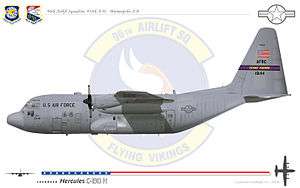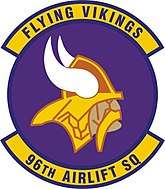96th Airlift Squadron
96th Airlift Squadron
 | |
|---|---|
 Profile of a squadron C-130H Hercules | |
| Active | 1943–1945; 1947–1951; 1952–present |
| Country |
|
| Branch |
|
| Type | Airlift |
| Part of | Air Force Reserve Command |
| Garrison/HQ | Minneapolis-St Paul Joint Air Reserve Station |
| Nickname(s) | Flying Vikings |
| Engagements |
Operation Overlord Operation Dragoon Operation Market Garden Battle of Bastogne[1] |
| Decorations |
Distinguished Unit Citation Air Force Outstanding Unit Award Republic of Vietnam Gallantry Cross with Palm[1] |
| Insignia | |
| 96th Airlift Squadron emblem (approved 18 June 1997)[1][note 1] |
 |
The 96th Airlift Squadron is part of the 934th Airlift Wing at Minneapolis-St Paul Joint Air Reserve Station, Minnesota. It operates Lockheed C-130 Hercules aircraft supporting the United States Air Force global reach mission worldwide.
Mission
Fly Lockheed C-130H Hercules cargo aircraft, both airdropping and airlanding cargo and people.
History
World War II
Activated in July 1943 as an I Troop Carrier Command Douglas C-47 Skytrain Squadron. After training in the United States, at various bases, sent to Baer Field, Indiana for final equipping with aircraft, personnel and other equipment. Deployed to IX Troop Carrier Command in February 1944 during the build-up prior to the invasion of France.
During the D-Day Invasion, the squadron dropped paratroops of the 101st Airborne Division in Normandy, subsequently flying numerous missions to bring in reinforcements and needed supplies. During the airborne attack on The Netherlands (Operation Market Garden, September 1944), the squadron dropped paratroops, towed gliders, and flew resupply missions. Later participated in the invasion of southern France in August 1944. The squadron supported the 101st Airborne Division in the Battle of the Bulge by towing gliders full of supplies near Bastogne on 27 December 1944. In addition, its units participated in the air assault across the Rhine River in early 1945 (Operation Varsity) and later flew numerous freight missions to carry gasoline, food, medicine, and other supplies to allied ground forces during the Western Allied invasion of Germany in April 1945 near Wesel. The squadron also hauled food, clothing, medicine, gasoline, ordnance equipment, and other supplies to the front lines and evacuated patients to rear zone hospitals. It transported displaced persons from Germany to France and Belgium after V-E Day. Remained in Europe during the summer of 1945, inactivating as part of the United States Air Forces in Europe, October 1945.
Reserve operations and mobilization for the Korean War
Reactivated in the reserve as a Curtiss C-46 Commando troop carrier squadron in Minneapolis, Minnesota during 1947. Was federalized as a result of the Korean War in 1951, squadron personnel and aircraft being sent to active-duty units as fillers, inactivated as an administrative unit a few days later.
Reactivation in the reserve
Reactivated after the Korean War as a reserve fighter-bomber squadron in 1952 initially equipped with North American F-51 Mustangs, later upgraded to Lockheed F-80 Shooting Star jet aircraft. Redesignated back to a troop carrier squadron in 1957. Carried out theater transport operations and supported Air Force and Army units with troop carrier missions. Was activated during the 1962 Cuban Missile Crisis, carried Army units to South Florida in preparation of a possible invasion of Cuba. Returned Army personnel to home stations after situation was normalized and returned to reserve service.
The squadron flew airlift missions worldwide, including to Southeast Asia during the Vietnam War and to Southwest Asia during the Gulf War. It has also participated in training exercises, some involving the dropping or landing of airborne troops, and flew numerous humanitarian airlift missions.
Campaigns and decorations
- Campaigns: World War II: Normandy; Northern France; Rome-Arno; Southern France; Rhineland; Ardennes-Alsace; Central Europe.
- Decorations: Distinguished Unit Citation: France, [6–7] Jun 1944. Air Force Outstanding Unit Awards: 1 Oct 1988 – 30 Sep 1990; 1 Jul 1994 – 30 Jun 1996; 30 Sep 1998 – 1 Oct 2000. Republic of Vietnam Gallantry Cross with Palm: 14 Feb-11 Mar 1968.
Lineage
- Constituted as the 96th Troop Carrier Squadron on 25 May 1943
- Activated on 1 July 1943
- Inactivated on 18 October 1945
- Activated in the reserve on 6 March 1947
- Redesignated 96th Troop Carrier Squadron, Medium on 27 June 1949
- Ordered to Active Service on 1 May 1951
- Inactivated on 4 May 1951
- Redesignated 96th Fighter-Bomber Squadron on 26 May 1952
- Activated in the Reserve on 15 June 1952
- Redesignated 96th Troop Carrier Squadron, Medium on 8 September 1957
- Ordered to active service on 28 October 1962
- Relieved from active service on 28 November 1962
- Redesignated 96th Tactical Airlift Squadron on 1 July 1967
- Redesignated 96th Airlift Squadron on 1 February 1992[1]
Assignments
- 440th Troop Carrier Group, 1 Jul 1943 – 18 Oct 1945
- Second Air Force, 6 March 1947
- 440th Troop Carrier Group, 3 Sep 1947 – 4 May 1951
- 440th Fighter-Bomber Group (later 440th Troop Carrier Group), 15 June 1952
- 440th Troop Carrier Wing, 14 April 1959
- 934th Troop Carrier Group (later 934 Tactical Airlift Group 934 Airlift Group), 11 February 1963
- 934th Operations Group, 1 Aug 1992 – present[1]
Stations
|
|
Aircraft
|
|
References
- Notes
- ↑ Thgis emblem replaced one approved on 28 July 1960. Maurer, Combat Squadrons, pp. 321-322.
- Citations
Bibliography
![]()
- Anderson, Capt. Barry (1985). Army Air Forces Stations: A Guide to the Stations Where U.S. Army Air Forces Personnel Served in the United Kingdom During World War II (PDF). Maxwell AFB, AL yes: Research Division, USAF Historical Research Center. Archived from the original (PDF) on January 23, 2016. Retrieved June 28, 2017.
- Cantwell, Gerald T. (1997). Citizen Airmen: a History of the Air Force Reserve, 1946-1994 (PDF). Washington, D.C.: Air Force History and Museums Program. ISBN 0-16049-269-6. Retrieved December 17, 2016.
- Johnson, 1st Lt. David C. (1988). U.S. Army Air Forces Continental Airfields (ETO) D-Day to V-E Day (PDF). Maxwell AFB, AL: Research Division, USAF Historical Research Center. Archived from the original (PDF) on September 29, 2015. Retrieved June 26, 2017.
- Maurer, Maurer, ed. (1983) [1961]. Air Force Combat Units of World War II (PDF) (reprint ed.). Washington, DC: Office of Air Force History. ISBN 0-912799-02-1. LCCN 61060979. Retrieved December 17, 2016.
- Maurer, Maurer, ed. (1982) [1969]. Combat Squadrons of the Air Force, World War II (PDF) (reprint ed.). Washington, DC: Office of Air Force History. ISBN 0-405-12194-6. LCCN 70605402. OCLC 72556. Retrieved December 17, 2016.
- Ravenstein, Charles A. (1984). Air Force Combat Wings, Lineage & Honors Histories 1947-1977 (PDF). Washington, DC: Office of Air Force History. ISBN 0-912799-12-9. Retrieved December 17, 2016.

.svg.png)